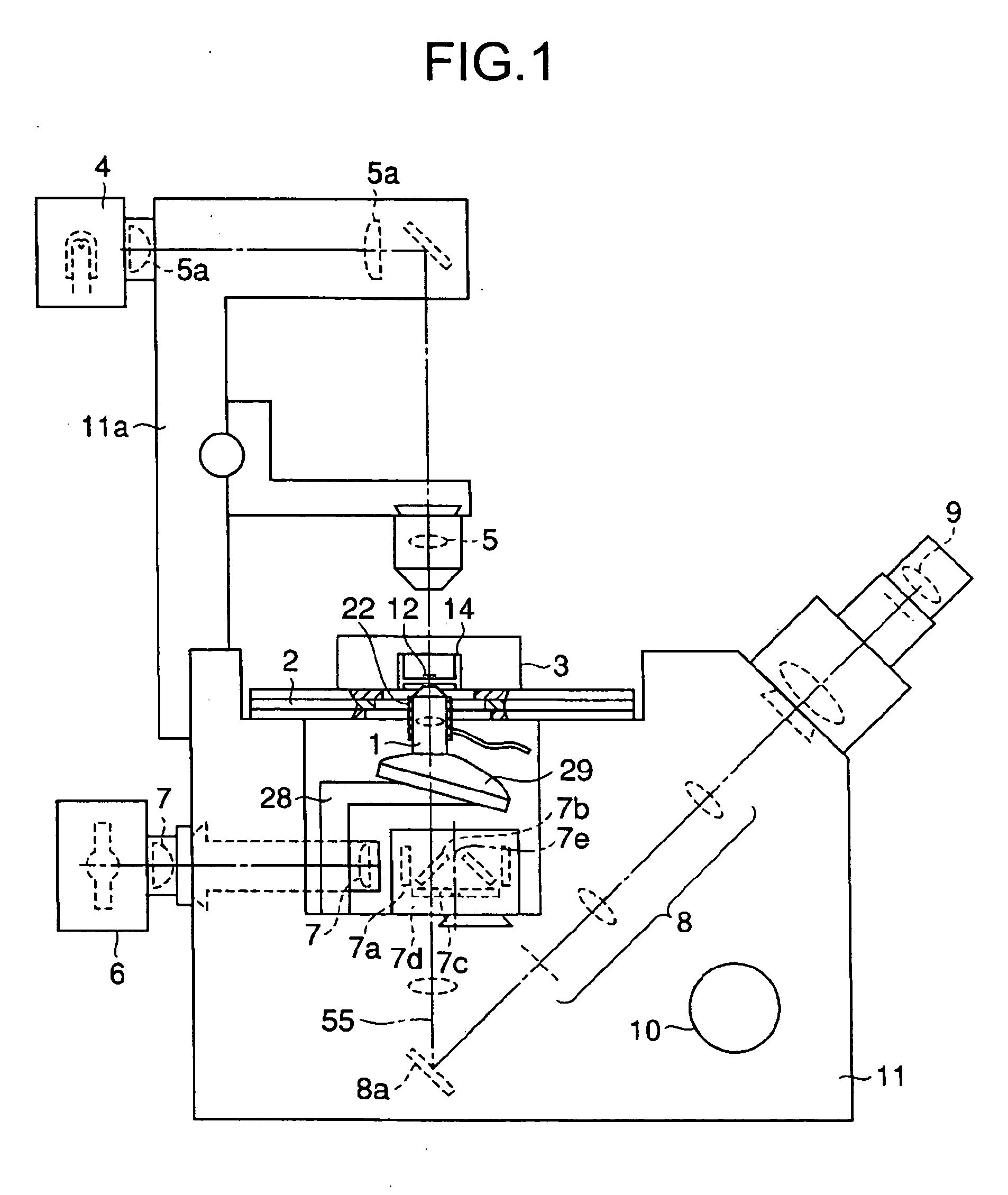Microscope and method of preventing dew condensation on objective lens
a technology of objective lens and microscope, which is applied in the direction of instruments, optical elements, mountings, etc., can solve the problems of significant degradation of thermal insulation effect, difficult to maintain the temperature of the cell at 37° c, and space inside the incubator is not completely thermally insulated from the outside air. , to achieve the effect of preventing dew condensation
- Summary
- Abstract
- Description
- Claims
- Application Information
AI Technical Summary
Benefits of technology
Problems solved by technology
Method used
Image
Examples
first embodiment
[0028]FIG. 1 shows a schematic structure of an inverted microscope according to the present invention.
[0029] In FIG. 1, on a main microscope housing 11, a stage 2 is disposed. The stage 2 is horizontally movable along an X-Y direction according to a manipulation of a stage handle (not shown). On the stage 2, a cell incubator 3 containing a cultured cell 12, which is a living sample, is placed. The cell incubator 3 will be described in detail later.
[0030] The main microscope housing 11 has a lighting pillar 11a which faces down to the stage 2. The lighting pillar 11a has a top portion which extends in a substantially horizontal direction forming a substantially right angle with a surface of the stage 2.
[0031] The lighting pillar 11a has a light source 4 for transmissive lighting. The light source 4 may be a halogen lamp, a mercury lamp, or the like. A light beam emitted from the light source 4 passes through an optical path on which a transmissive lighting optical system 5a and a c...
second embodiment
[0058] Next, the present invention will be described.
[0059]FIG. 3 shows a schematic structure of main parts of a microscope according to the second embodiment of the present invention, and the same reference characters are assigned to the same elements shown in FIGS. 1 and 2.
[0060] Here, the objective lens 1 has the top lens 1a and a group of other lenses 1a1 adhesively fixed to an opening of a cylindrical inner frame 1b. The inner frame 1b is fit into a void in a cylindrical middle frame 1d and secured by a holding tube 1c. On an outer periphery of the middle frame 1d, the sheet-like heater 22 having an electrically-heated coil is adhesively fixed. An outer periphery of the heater 22 is covered by an outer frame 1e which is screwed into the middle frame 1d and secured.
[0061] The objective lens 1 with the above-described structure is detachably fixed to the revolver 29 via a threaded portion 1f provided at a lower portion of the outer frame 1e.
[0062] On the other hand, the revolv...
third embodiment
[0082] Next, the present invention will be described.
[0083] In the first and the second embodiments described above, the objective lens 1 in the cell incubator 3 disposed on the stage 2 of the inverted microscope is heated in order to achieve prevention of dew condensation on the objective lens 1. In a microscope with a cell incubator according to the third embodiment, substantially the entire microscope including the objective lens can be heated.
[0084]FIG. 6 shows a schematic structure of main parts of a microscope with a cell incubator according to the third embodiment. The same reference characters are assigned to the same elements as shown in FIG. 2. Here, the microscope with the cell incubator generally has three spaces, i.e.:
[0085] (a) a cell culture space 37 which temperature, humidity and CO2 concentration are controlled;
[0086] (b) an observation space 38 of the microscope including the objective lens 1 in which only temperature is controlled;
[0087] (c) a space 381 provi...
PUM
 Login to View More
Login to View More Abstract
Description
Claims
Application Information
 Login to View More
Login to View More - R&D
- Intellectual Property
- Life Sciences
- Materials
- Tech Scout
- Unparalleled Data Quality
- Higher Quality Content
- 60% Fewer Hallucinations
Browse by: Latest US Patents, China's latest patents, Technical Efficacy Thesaurus, Application Domain, Technology Topic, Popular Technical Reports.
© 2025 PatSnap. All rights reserved.Legal|Privacy policy|Modern Slavery Act Transparency Statement|Sitemap|About US| Contact US: help@patsnap.com



